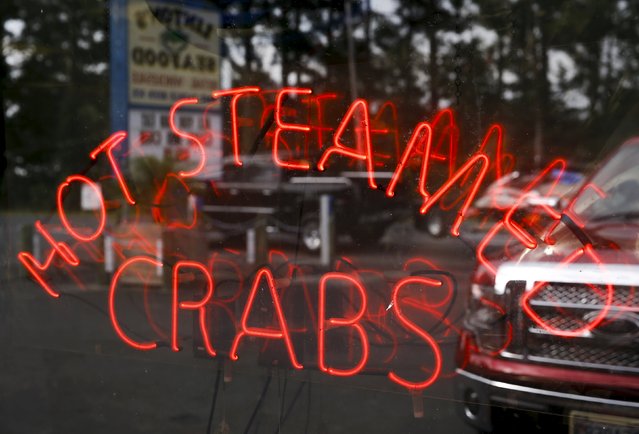
Linton's Seafood shop and restaurant advertises crabs for sale in the Eastern Shore town of Crisfield, Maryland September 5, 2015. Young people in the small rural shore towns of Chesapeake Bay, which straddles the eastern U.S. states of Maryland and Virginia, are shunning the erratic pay of "watermen", who catch crabs using skills such as baiting a crab pot or handling a trotline, previously passed down through the generations. Seasonal workers from Mexico fill many of the manual jobs in picking houses to process the crustaceans. The industry faces other headwinds, environmental issues and an increasingly global agricultural market among them. Last year's harvest was the lowest recorded in 25 years after the crab population crashed in the 1990s and early 2000s. (Photo by Jonathan Ernst/Reuters)
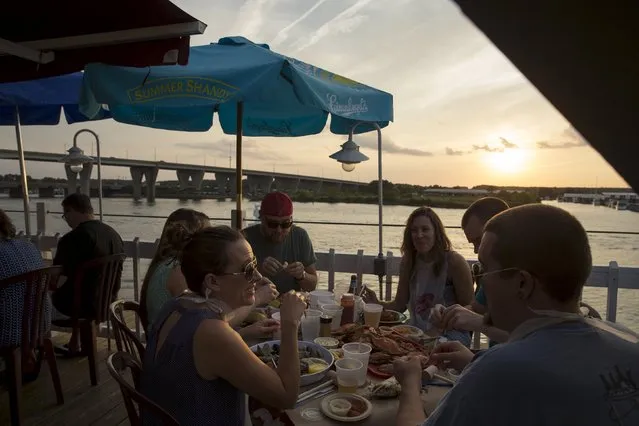
Diners eat blue crabs as the sun sets over the Kent Narrows at Harris Crab House in Grasonville, Maryland September 5, 2015. (Photo by Jonathan Ernst/Reuters)
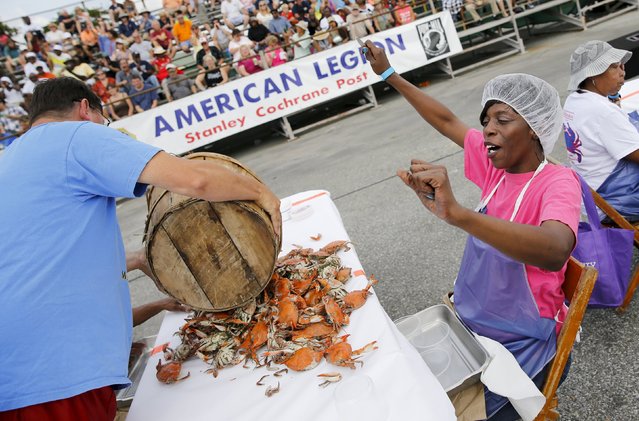
A contestant cheers for the start of the crab-picking contest, for professional pickers from local seafood businesses, during the annual National Hard Crab Derby in Crisfield, Maryland September 5, 2015. The town of Crisfield hosts the festival each year to celebrate and highlight the importance of the crab industry to their economy. (Photo by Jonathan Ernst/Reuters)
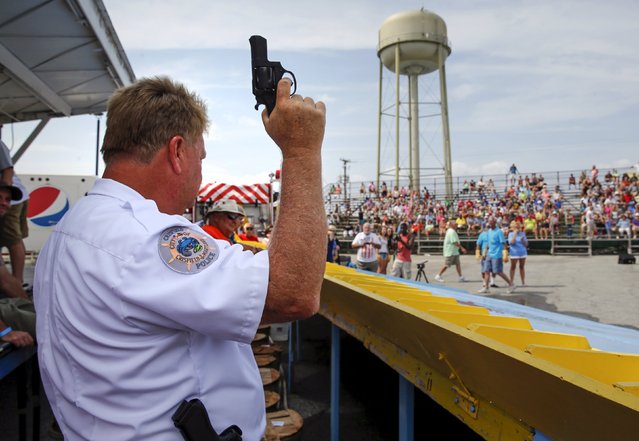
Crisfield Police Chief Michael Tabor prepares to fire the starter pistol for a crab "race" during the annual National Hard Crab Derby in Crisfield, Maryland September 5, 2015. (Photo by Jonathan Ernst/Reuters)
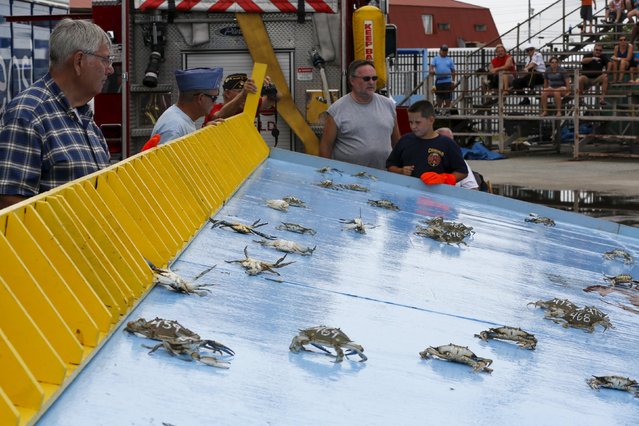
Crabs "race" for contestants' bragging rights during the annual National Hard Crab Derby in Crisfield, Maryland September 5, 2015. (Photo by Jonathan Ernst/Reuters)
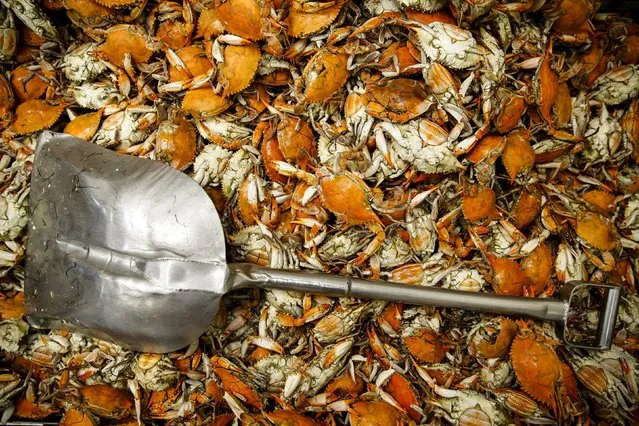
A large stainless steel shovel lies on top of steamed crabs at the A.E. Phillips & Son Inc. crab picking house on Hooper's Island in Fishing Creek, Maryland August 26, 2015. Workers speed through the lump and back fin meat inside the crabs while leaving the more tedious task of picking the claws to others. (Photo by Jonathan Ernst/Reuters)
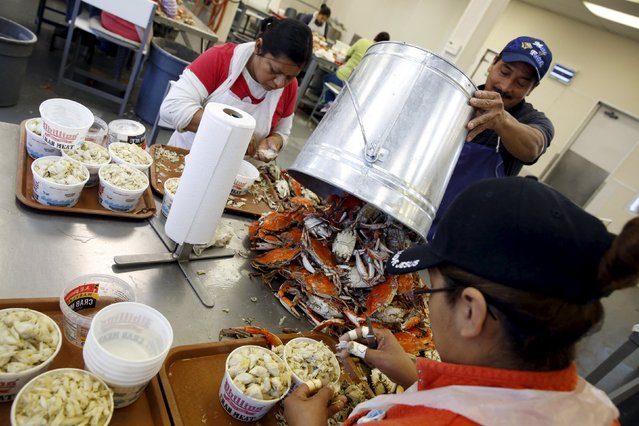
Mexican workers, on the U.S. H2B visa program for seasonal guest workers, process crabs at the A.E. Phillips & Son Inc. crab picking house on Hooper's Island in Fishing Creek, Maryland August 26, 2015. Phillips has claimed pioneering status in the Chesapeake crab industry since 1956, when they opened their own restaurant in Ocean City, Maryland, and today still run the picking operation on Hooper's Island to provide crabs to their network of eateries. (Photo by Jonathan Ernst/Reuters)
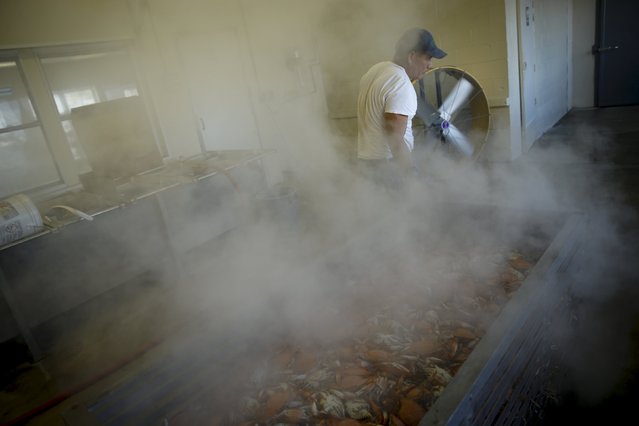
A worker unloads a carriage of cooked crabs from a large pressure steamer at the A.E. Phillips & Son Inc. crab picking house on Hooper's Island in Fishing Creek, Maryland August 26, 2015. The crabs will be chilled overnight before the meat is picked the next morning by guest workers who make up the picking house's primary workforce during the April-November season each year. (Photo by Jonathan Ernst/Reuters)
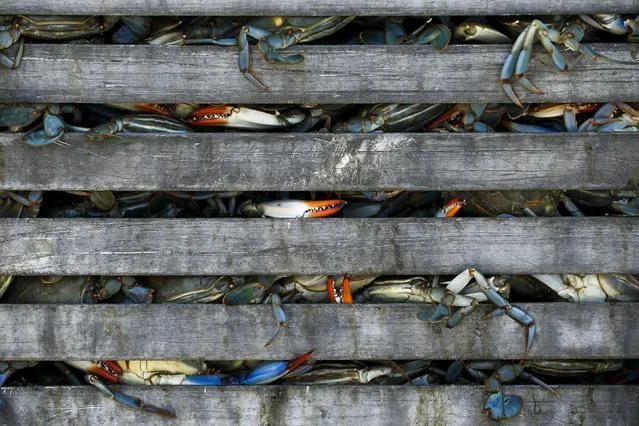
Workers unload bushel baskets of live blue crabs into a large carriage before pressure steaming them at the A.E. Phillips & Son Inc. crab picking house on Hooper's Island in Fishing Creek, Maryland August 26, 2015. (Photo by Jonathan Ernst/Reuters)
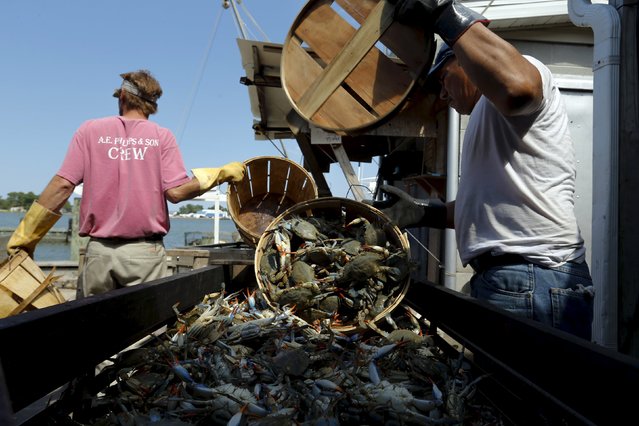
Workers unload bushel baskets of live blue crabs into a large carriage before pressure steaming them at the A.E. Phillips & Son Inc. crab picking house on Hooper's Island in Fishing Creek, Maryland August 26, 2015. (Photo by Jonathan Ernst/Reuters)
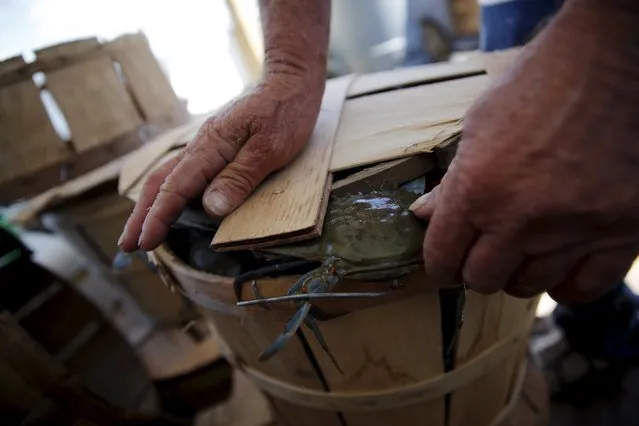
Professional waterman Danny Richardson tries to fit one more crab into a bushel basket as he works a trot line on the Choptank River near Cambridge, Maryland August 28, 2015. Richardson and his partner's fishing licenses allowed them to catch up to 13 bushels of crabs that day; the daily limit can vary during the season. (Photo by Jonathan Ernst/Reuters)
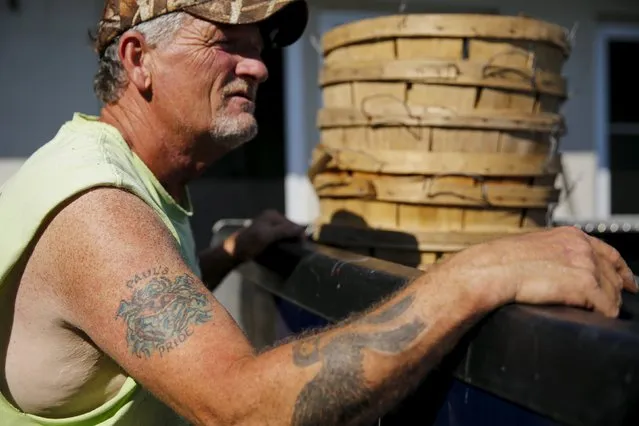
Waterman Dwane Paul delivers his day's catch at the A.E. Phillips & Son Inc. crab picking house on Hooper's Island in Fishing Creek, Maryland August 26, 2015. Paul's two sons have followed him into the fishing trade, although he had hopes they might choose a different profession. (Photo by Jonathan Ernst/Reuters)
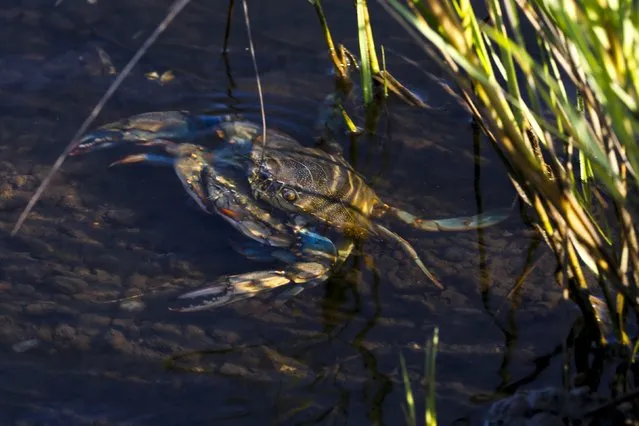
A mating pair of crabs, or "doublers" in the local parlance, skirt the grass along the shore near the Taylors Island Wildlife Management Area in Taylors Island, Maryland August 27, 2015. A male crab attaches himself to a female when she has moulted her hard shell and is nearly ready to mate. He latches onto her for a day or two while they mate and protects her until her new shell has hardened. (Photo by Jonathan Ernst/Reuters)
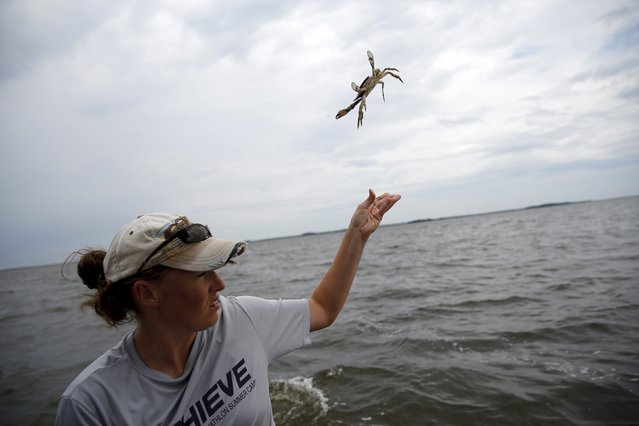
Researcher Keira Heggie from the Smithsonian Environmental Research Center (SERC) releases a crab back into the water after tagging it with a plastic marker as part of a study in the Nanticoke River, a tributary of the Chesapeake Bay, near Tyaskin, Maryland August 25, 2015. SERC offers a reward to people who find a tagged crab. A $5 reward is offered for some of the crabs and others a $50 reward, the difference helping to determine the accuracy of the data. The researchers assume that most people who catch the $50-labelled crab will phone in the tag number to collect their reward. SERC's research on migration patterns informs the management of the crab fisheries and the setting of fishing limits in the area. This can be a point of contention between crabbers and government regulators who rely on the environmental research. (Photo by Jonathan Ernst/Reuters)
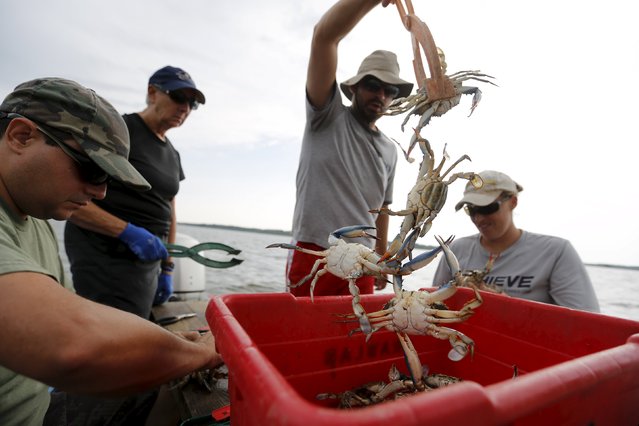
Researchers from the Smithsonian Environmental Research Center (SERC) tag crabs and release them back into the Nanticoke River, a tributary of the Chesapeake Bay, near Tyaskin, Maryland August 25, 2015. (Photo by Jonathan Ernst/Reuters)
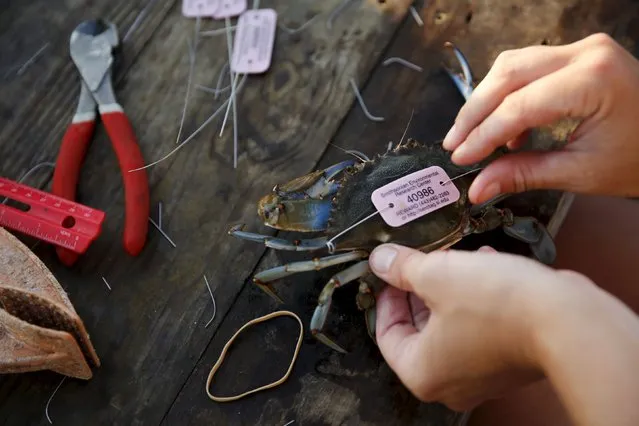
A plastic tag is attached to a crab by a researcher from the Smithsonian Environmental Research Center (SERC) on a boat in the Nanticoke River, a tributary of the Chesapeake Bay, near Tyaskin, Maryland August 25, 2015. (Photo by Jonathan Ernst/Reuters)

Blue crabs wait to be tagged by researchers from the Smithsonian Environmental Research Center (SERC) before being released back into the Nanticoke River, a tributary of the Chesapeake Bay, near Tyaskin, Maryland August 25, 2015. (Photo by Jonathan Ernst/Reuters)
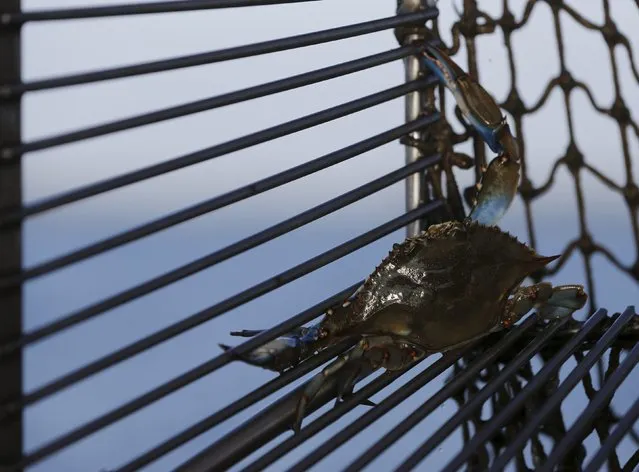
A crab clings to the catch basket as professional watermen Jeff Robinson and Danny Richardson fish for crabs on the Choptank River near Cambridge, Maryland August 28, 2015. Their fishing licenses allowed them to catch up to 13 bushels of crabs that day; the daily limit can vary during the season. (Photo by Jonathan Ernst/Reuters)
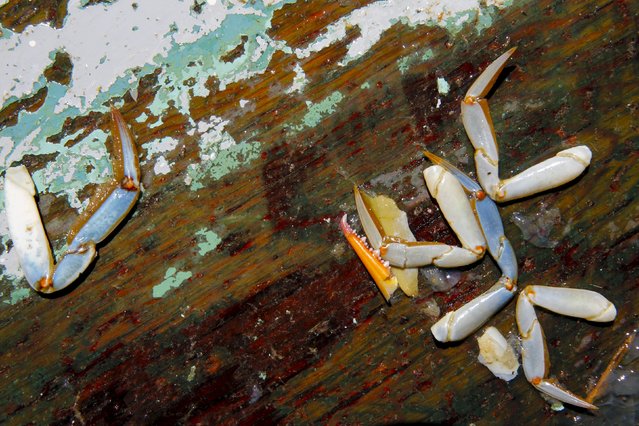
Parts of crabs and jellyfish lie on a wooden sorting table as professional watermen Jeff Robinson and Danny Richardson fish for crabs on the Choptank River near Cambridge, Maryland August 28, 2015. Their fishing licenses allowed them to catch up to 13 bushels of crabs that day, the daily limit can vary during the season. (Photo by Jonathan Ernst/Reuters)
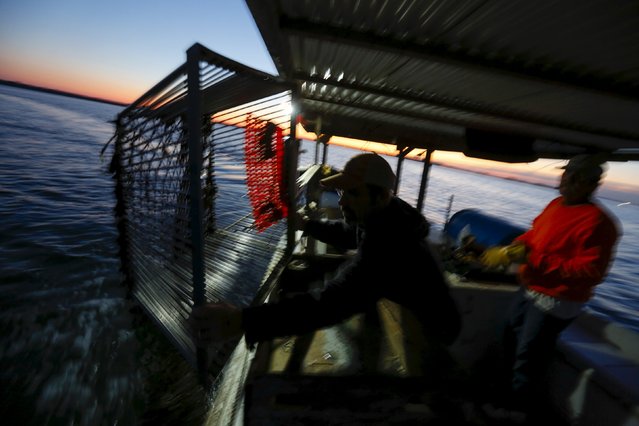
Professional watermen Jeff Robinson (C) and Danny Richardson (R) deploy a trotline as they fish for crabs on the Choptank River near Cambridge, Maryland August 28, 2015. (Photo by Jonathan Ernst/Reuters)
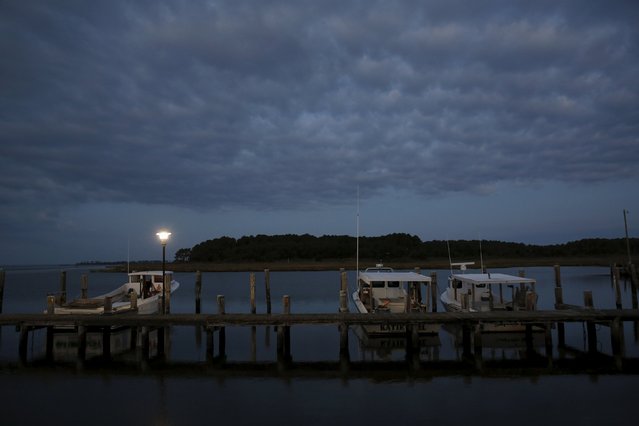
Crab boats are moored at the dock at dawn on Hooper's Island, Maryland August 26, 2015. (Photo by Jonathan Ernst/Reuters)
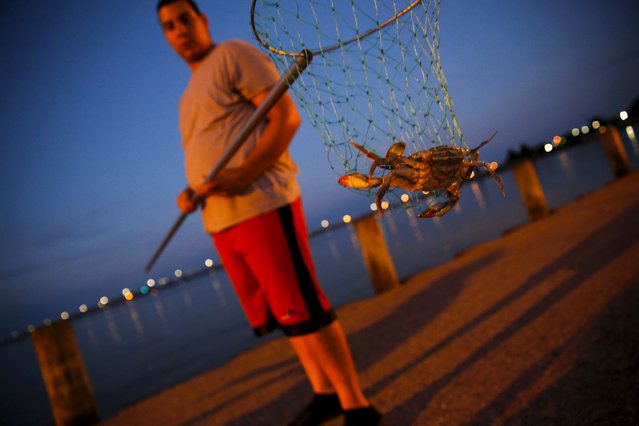
Josue Vega nets crabs one-by-one with his family at a parking lot abutting Long Wharf Park in Cambridge, Maryland August 26, 2015. (Photo by Jonathan Ernst/Reuters)
16 Oct 2015 08:03:00,
post received
0 comments
